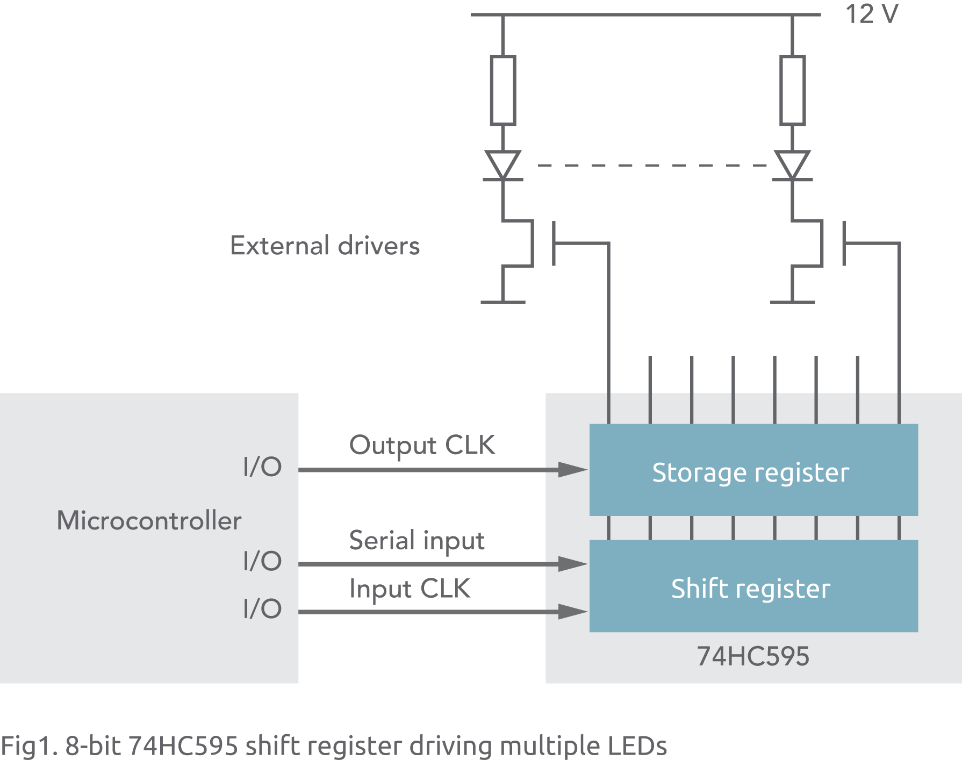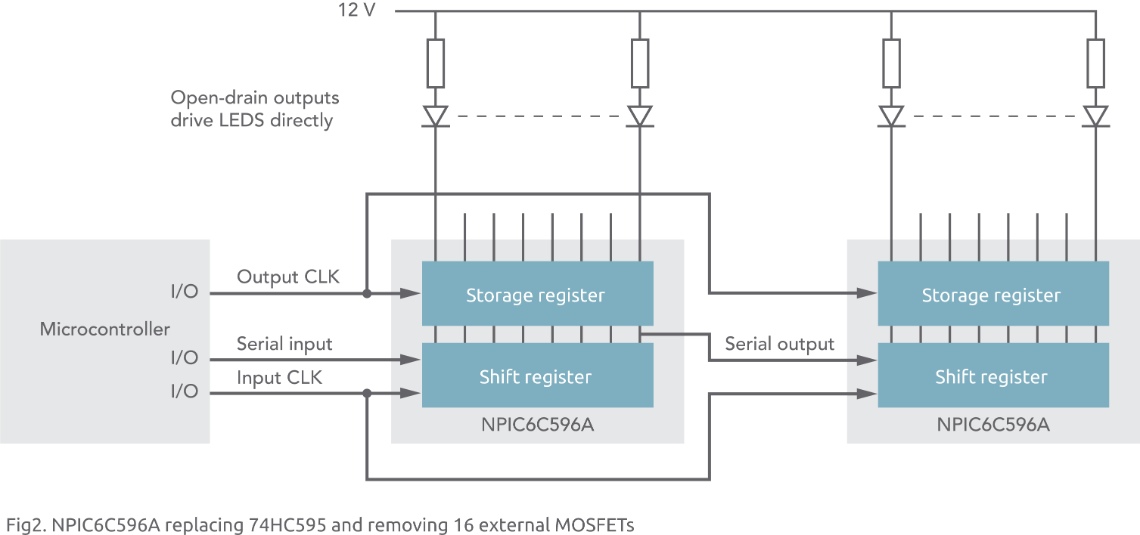Shift registers from Nexperia's logic portfolio can help reduce size and BOM in designs that use LEDs. By providing I/O expansion, shift registers enable the use of less expensive microcontrollers with fewer pins.
Shift registers can help reduce size and BOM in designs that use LEDs. By providing I/O expansion, shift registers enable the use of less expensive microcontrollers with fewer pins.
For example, if a system includes a seven-segment display, a single indicator or an array of LEDs that form a grid or panel, a standard 8-bit shift register can be used to let a low pin-count microcontroller drive several LEDs. A single 5 V 74HC595 shift register, with serial inputs and serial or parallel outputs, can provide I/O expansion for the microcontroller.
Drive more LEDs with logic to minimize MCU costs
As shown in Figure 1, using 74HC595 for I/O expansion only requires three MCU control pins to drive up to eight LEDs. Reducing the number of control pins offers the opportunity to use a MCU with a lower pin count, which results in a smaller, more cost-effective design.

Since 74HC595 includes a serial output, several devices can be even be cascaded together, allowing for reducing the total number of microcontrollers in a design, to reduce size and cost further.
In some cases, the shift register can be used to drive a variety of LEDs directly and thus eliminate the need for external LED drivers -when the LEDs are specified for up to 6 V with a forward current of less than 20 mA. However, a discrete external LED driver would be required beyond these values. In this case and in many more, NPIC6C596A offers further opportunities.
Add more features to 74HC595 with our NPIC6C family
Per figure 2, NPIC6C596A combines shift register functions similar to 74HC595 with a high-voltage (HV) MOSFET driver, while also adding the open-drain output feature. NPIC6C solutions are typically used for applications such as graphic status and fault status indicators.
By using NPIC6C596A, a compact single-chip solution can be found for a wider range of LEDs, including for those operating at voltages up to 33 V and with a higher forward current than 74HC595 allows.

Our NPIC6C series of devices have open-drain outputs that are tolerant to 33 V. Each output is designed to sink 100 mA and there is no limit on ground current. All the outputs can actively sink 100 mA simultaneously. The outputs include current-limiting circuitry, which sets a 250 mA maximum on the sinkable current, and each output also includes (thermal) protection thanks to output clamping.
Circuitry built in NPIC6C limits the maximum current each output can sink. As the drain voltage increases, the drain source current decreases, to protect the outputs and components they are driving. Besides, clamp current is inversely proportional to temperature. As the temperature increases, the output resistance increases, thus limiting drain source current and again preventing damage to the output and components it drives. At 25 °C, output clamp is typically activated when drain source current is 250 mA and the output typically limits the drain source current to 120 mA.
Reduce solution footprint with NPIC6C -including for Automotive applications
To sum up, when LEDs are part of the design, shift registers make it possible to use a more compact, less expensive microcontroller. Standard 8-bit shift registers like the popular 74HC595 and the more advanced NPIC6C series are available from Nexperia. Our NPIC6C range includes 8-bit and 12-bit solutions which address 5V control logic needs and more. All NPIC6C devices include a serial output for cascading and allow for an input clock frequency of at least 10 MHz. Part of our NPIC6C portfolio offers serial output delay to provide longer data hold time, improving the timing margin and making it easier to cascade many shift registers. Our NPIC6C series is available in industry-standard TSSOP leaded packages and also DQFN leadless packages that save space and include a heat sink, ideal for use at higher currents. Q100 variants exist for Automotive applications.
| Type number | Format | Supply voltage (V) | fmax (MHz) | Tamb (°C) | QS clock | Packages |
|---|---|---|---|---|---|---|
| NPIC6C595 | 8-bit | 4.5 to 5.5 | 10 | -40 to +125 | Rise | SO16, TSSOP16, DQFN16 |
| NPIC6C596 | 8-bit | 4.5 to 5.5 | 10 | -40 to +125 | Fall |
SO16, TSSOP16, DQFN16 |
| NPIC6C596A | 8-bit | 2.3 to 5.5 | 10 | -40 to +125 | Fall |
SO16, TSSOP16, DQFN16 |
| NPIC6C4894 | 12-bit | 4.5 to 5.5 | 10 | -40 to +125 | Rise |
SO20, TSSOP20, DQFN20 |